|
1.
CENTRAL/ WEST AFRICA
Gabon implements log quotas
Once again, exporters managed to hold prices for both
logs and lumber mostly unchanged through the second
half of February. LM grade afrormosia for Europe gained
around EUR40 m3 but as volumes are very small for this
rare species, this may be just a one-off transaction. Azobe
also was back in demand from Europe and triggered a rise
of EUR15 for LM and B grades.
The most important news from the region was the
announcement from Gabon of quota volumes for
qualifying timber companies. There were mixed reactions
from the companies, as a number felt their volume
allocation was insufficient, while others were resigned to
workable volumes. Excluding January, the planned export
log volume for the remaining 11 months of 2008 is just
under 1.6 million m3. Of this, 350,000m3 was allocated to
the State owned SNBG, the enterprise that previously held
the monopoly for export of logs. All the exporting
companies with the exception SNBG now have to be
equipped with or be advanced in building processing
facilities. More stringent controls are proposed on
checking volumes by a technical facility that was
separated from SNBG and the customs department.
Although the government of Equatorial Guinea recently
banned the export of logs, it is understood that substantial
volumes are still being shipped out of the country. Exports
as much as 30,000m3 per month are rumored. Reports also
say that log exports from Congo Brazzaville can be in
excess of the planned quota for those companies involved
in reforestation projects.
Lumber prices also have remained steady and unchanged.
As mentioned in mid-January (TTM 13:1), some exporters
thought Malaysian prices for meranti and other timbers
would undercut current West African price trends, but this
has not occurred. In fact, more active competition may
well once again be from Brazilian timber, which is priced
in US dollars. The euro has been rising strongly against
the dollar in the past few weeks and this may well
influence European importers to try some of the less
familiar South American species. However, many of these
are not alternatives for the medium-density prime West
African mahogany-type species. There is risk in a general
slowdown in the market, although so far the construction
industries in UK and continental Europe have kept busy,
helped by the relatively mild winter weather.
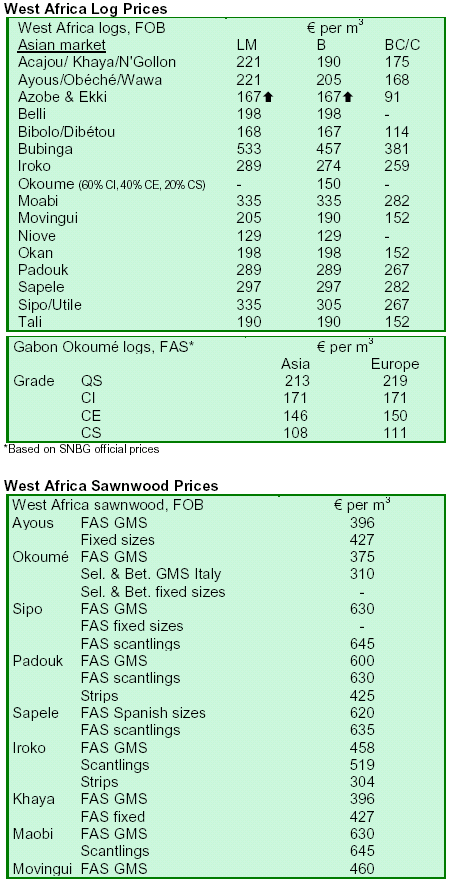
2. GHANA
Minister revokes timber company license
Mrs. Esther Obeng Dapaah, Ghana¡¯s Minister for Lands
and Forestry and Mines, has directed the Forestry
Commission (FC) to revoke the license granted to Messrs
Royal Visage, a timber company, which harvests teak in
the Bomfobiri Wildlife Sanctuary. Revocation of the
timber license will take immediate effect. She explained
that the granting of timber harvesting rights to Messrs
Royal Visage by the FC had no legal justification and did
not follow legal procedures, which ran contrary to the
provisions of the existing management plans for the
Sanctuary.
According to the Minister, the decision to revoke the
license is part of recommendations made by a committee
established by the Ministry to investigate the
circumstances under which the permit was granted to
Messrs Royal Visage to harvest timber from the Bomfobiri
Sanctuary. The committee found that statistics provided
from a field assessment, which formed the basis for the
granting of the quantity teak harvesting allowances to
Messrs Royal Vintage, had serious errors because of the
low-level of competency of the field staff.
In a press statement on the harvesting of teak from the
Sanctuary, the Minister announced the license revocation
and directed the Chief Executive of the FC present a
detailed report of all harvesting permits issued over the
last twelve months. The report is expected to include the
names, addresses and locations of all recipient companies,
the extent and location of the permit area, the extent of
total stock of timber harvested and all associated financial
obligations. The FC has also been tasked to identify all
potential harvestable plantation sites so they can be
documented and advertised periodically for prospective
bidders. The Minister has also placed a ban on the granting
of timber harvesting rights in buffer zones of protected
areas such as those in globally significant biological areas
(GSBAs) and other special biological areas or any wildlife
protected areas.
Ghana¡¯s timber exports jump 17% in 2007
Ghana¡¯s timber and wood products exports during the
period January to December 2007 were 528,570 m3 in
volume and valued at EUR 184.17 million. Compared to
the same period in 2006, this represented an increase of
17% in volume and 8.3% in value. Secondary products
altogether amounted to EUR167.92 million from January
to December 2007 compared to EUR152.07 million during
the same period in 2006. The following chart outlines the
major trends of Ghana¡¯s cumulative total export volume
and value data for the period under review:

Kiln dried lumber exports in 2007 were 120,480 m3, or
22.8% of total export volume. This was a 6.1% increase in
volume when compared to 2006 levels. Kiln dried lumber
exports generated 7.7% more revenue, rising from
EUR44.12 in 2006 to EUR 47.51 million in 2007. For the
year 2007, the total volume of air-dried lumber, including
overland exports, dropped by 11.3% and registered 85,170
m3 in volume compared to the previous year. Earnings also
fell 16.4% from 2006 earnings.
When compared to 2006, the EU continued as Ghana¡¯s
leading trading partner in wood products for 2007,
accounting for 160,278 m3 in volume and EUR 77.70
million in value. This represented 30.32% and 42.19% in
volume and value, respectively, of total wood exports for
2007. Germany, France, Italy, Belgium, Spain, the UK,
Ireland, and the Netherlands were the key markets for
Ghana¡¯s wood products. Exports to the US market in 2007
were 10.40% in volume and 13.26% in value of the total
export volume, compared to 11.79% and 14.10%,
respectively, in 2006.
Ghana¡¯s wood exports to states in the West African region
were EUR31.96 million, or 81.45% of the total market
value for Africa. Plywood and air-dried lumber were
mainly for the intra-regional trade to Senegalese and
Nigerian markets. Wood products exports to Malaysia,
China, Taiwan, India, Singapore and Thailand totaled
EUR 33.04 million.
Forest fires cause 3% GDP loss
Forest fires have caused an estimated annual loss of about
3% of the Ghana¡¯s GDP over the last 15 years, the Deputy
Minister of Lands, Forestry and Mines has recently stated.
The Minister explained that wildfires, especially those in
transitional and savannah zones caused the most
significant deforestation and degradation in Ghana.
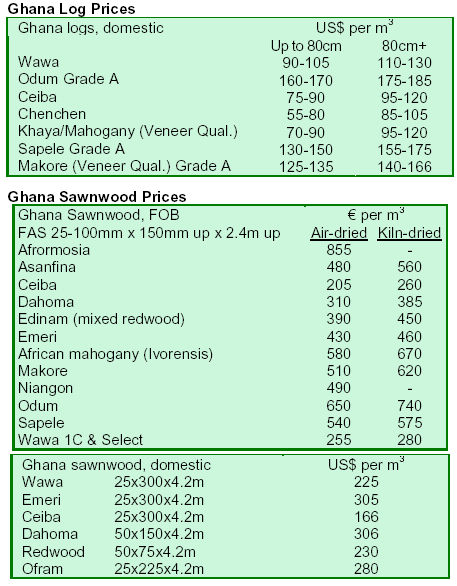
3.
MALAYSIA
Malaysian International Furniture Fair to be held in March
The annual Malaysian International Furniture Fair (MIFF
2008) will be held this year at two separate venues, the
MATRADE Exhibition and Convention Center (MECC)
and the Putra World Trade (PWTC) in Kuala Lumpur,
Malaysia, during 4-8 March 2008. The Fair will consist of
a total exhibition space of 80,000 m2. Last year, MIFF
2007 attracted 7,266 international buyers from 135
countries and generated USD667 million (RM2.33 billion)
in sales.
Weak markets make oil palm investments more attractive
The Edge Daily has reported that prices of Malaysian
timber products remain steady despite mounting
uncertainty in two of Malaysia¡¯s biggest export markets,
the US and Japan. Recent weakening of timber prices has
prompted some Malaysian state governments to
intensively utilize more available land for the planting of
oil palm. Crude palm oil (CPO) futures surged to a record
MYR3,646 (USD1,132) per ton recently as a result of
strong demand from China and spiraling soybean and soy
oil prices. Analysts have also speculated that palm oil
prices will continue to rise.
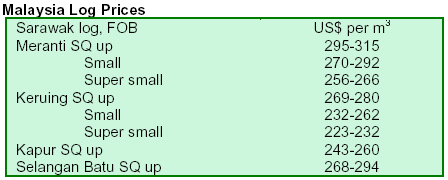
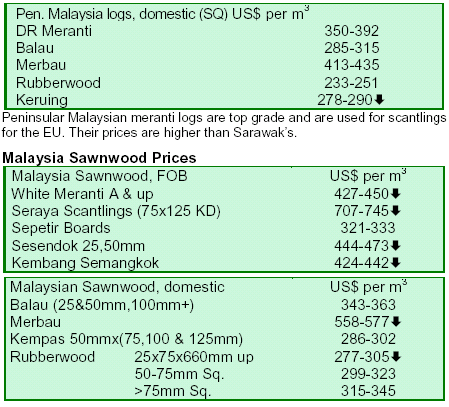
4.
INDONESIA
China demand and BNI report boost Indonesia prices
Prices of Indonesian timber products were mixed. Demand
from China has helped prevent a drastic slide in prices.
Prices were further supported by a recent announcement
by Bank Negara Indonesia (BNI), which stated that a 40%
increase in housing loans was expected this year. The
Jakarta Post reported on BNI¡¯s forecast, which was based
on strong demand for housing loans and a robust housing
industry. BNI estimated that housing credits were growing
yearly, with a total need for 400,000 units annually.
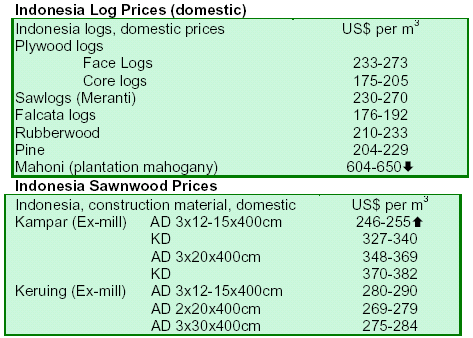
5.
MYANMAR
Business as usual reported in Myanmar
Prices for Myanmar teak logs continue to be relatively
strong, although prices have come down in the European
market. Nevertheless, January tender prices showed
European grades as firm, and Asian (especially Indian)
grades falling slightly. The market for sawn teak has not
been very strong, but orders for standard sizes have kept
coming.
Additionally, at the beginning of March, the Myanmar
Timber Enterprise and the Myanmar Timber Merchants¡¯
Association will convene the 2008 Myanmar Furniture
Fair (MFF ¡®08) from 3-8 March 2008 in Yangon,
Myanmar. Over 40 foreign and local furniture-related
companies were reported to have participated in the 2006
Myanmar furniture fair.

6. PAPUA
NEW GUINEA
Forest Minister announces phase out of log exports by 2010
Forest Minister Belden Namah announced that PNG will
phase out exports of logs by 2010 and develop
downstream processing, reported The National. One
potential impact of this action may be a loss of nearly
K450 million in export revenue. On the other hand,
landowners¡¯ income may also rise, as the authorities have
instituted a K20 per m3 rise in royalties for landowners.
Mr. Namah also encouraged the development of
downstream processing in the forestry sector and
suggested that logging projects should provide secondary
benefits to communities, such as improved roads and other
infrastructure. Namah noted that if companies did not
comply with logging laws, they would have their timber
permits revoked.

7.
BRAZIL
Timber sector crisis continues in Mato Grosso
Di¡§¢rio de Cuiab¡§¢ has reported concerns of the Timber
Industry Union of the Northern Region of Mato Grosso
State (SINDUSMAD) over the potential economic
consequences of a recent federal law, 6321/2007. The law,
which prohibits the opening of new logging areas in
municipalities identified as deforested, may significantly
impact regions that depend on timber for their economic
returns. The Union is also worried about the abuse of
power during inspections by the federal authority in Sinop
municipality.
Sinop is a timber manufacturing and trade cluster, but raw
material comes from areas where the National Institute for
Space Research (INPE) has detected new deforestation.
About 70% of Sinop¡¯s economically active population
works directly or indirectly with timber-related activities.
The municipality is a commercial cluster for trade in
machinery, equipment and parts for the regional timber
industry and the Western part of the state of Par¡§¢. The
timber sector in Sinop is particularly concerned about the
law because sector representatives believe that the
environmental and land agencies do not have the
operational capacity to meet the demand of those who
need to follow the new governmental measure.
Deforestation continues in extractive reserves of Northern Brazil
Deforestation in the Brazilian Amazon continues to be a
problem, according to recent news reports in Estadão
Online. Social activists in the region have claimed that
loggers have been illegally harvesting at the 358,000
hectare Renascer Extractive Forest Reserve in the
municipality of Prainha of Southeastern Para. Logging has
occurred mostly at night, when there is no inspection or
control by the Brazilian Institute of Environment and
Renewable Natural Resources (IBAMA). Those who
claim to have observed illegal logging are often threatened
with death and excluded from the reserve.
A letter alleging the illegal harvesting of high quality
timber species within the Renascer Reserve was sent to the
Environmental Minister and the Secretary of the
Environment of Para State. The letter was signed by 10
members of various local associations of Prainha
Municipality, including the rural and urban women¡¯s
association, farmers, fishermen and two members of the
local government.
According to these associations, public consultations
carried out during December 2007 to discuss the creation
of the Reserve were not able to stop the illegal logging
activity. Deforestation was more aggressive during the
Carnival holidays in early February 2008. Logging
companies¡¯ log stocks are piled up on the riverbank of the
Rio Uruara, a tributary of the Amazon River. An
inspection request to the IBAMA Regional Office of
Santarem municipality to control the deforestation did not
result in any positive changes.
The IBAMA Santarem Office has reportedly been
mapping the areas where the deforestation is taking place
in Prainha. Loggers have denied illegal logging within the
reserve and blamed environmental agencies for the delay
in the approval of forest management plans. They further
blame such delay to be causing unemployment in the
region.
Community and solidwood producers clash in Para
Folha de Sao Paulo said solidwood producers and
policeman clashed in the municipality of Tailandia in
Southeastern Para during a fierce protest against an illegal
logging enforcement operation carried out by IBAMA.
IBAMA has implemented the ¡®Guardian of the Amazon
Operation¡¯ since mid-February, under which illegal
logging investigations are conducted. IBAMA has
determined that a total of 13,000 m3 of sawnlogs have
been illegally harvested and confiscated. The confiscated
logs are reported to be worth BRL5 million and around
BRL1.5 million was charged in fines.
The uprising over illegal logging investigation resulted in
the closure of a bridge on the PA-150 state road, since
about 1,000 protesters crossed the bridge and eventually
confronted authorities that were confiscating the logs
identified by IBAMA as illegal. About 2,000 protesters
blocked the exit of IBAMA staff from a sawmill.
Community workers and authorities worry about the risk
of unemployment and its effect on the town¡¯s economy,
70% of which is based on timber products, if the
investigations continue. IBAMA and the State Secretary of
the Environment said they interrupted the enforcement
operations for safety reasons, although the state governor
has signaled that the government will not back off from
confiscating and removing any logs identified as illegal.
January exports rise by 7.7%
In January 2008, Brazilian exports of general wood
products (except pulp and paper) increased 7.7%
compared to the same period in 2007, growing from
USD300 million to USD323 million in value. The chart
below outlines trends for pine sawnwood, tropical
sawnwood, pine plywood, tropical plywood and wood
furniture in January 2007 and 2008:
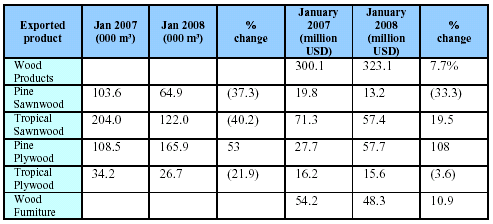
State of
Para shows strong export data for 2007
Recent data on tropical timber exports from the Brazilian
Ministry of Development, Industry and Commerce
(MDIC) indicate that the value of timber product exports
from the Amazon state of Para was more significant than
the total volume of exports in 2007. From 2006 to 2007,
the gross value of exports grew 22.9%, from USD645
million to USD793 million, while the volume exported
increased only 2.2%. The Association of Timber
Exporting Companies of Par¡§¢ (AIMEX) indicates that the
result reflects price adjustment that compensated for the
stronger Brazilian real against the US dollar within the
period analyzed.
Although the growth of exported volume was small,
timber companies needed to be supplied with timber from
other regions. Many companies purchased timber from
states such as Mato Grosso and Amazonas due to the
difficulty in obtaining raw material from Para. The timber
shortage in Para occurred because of the low number of
forest management projects approved last year.
The IBAMA Forest Products Trade and Transportation
System (Sisflora) indicates that 3.5 million m3 of raw
material were registered in 2007, with 95% of raw
material coming from natural forests and 5% from planted
forests. According to the Amazon Institute for People and
the Environment (IMAZON), 11 million m3 of raw
material is necessary to meet the demand of the timber
sector. Forest plantations have grown in Brazil and
comprise 5% of total tropical logs consumed in 2007. Of
this total, BRL 1.6 billion in revenue came from exports
and the remaining from sales to other states. At the state
level, Sisflora shows that the forest sector engaged in trade
worth BRL 3.4 billion of forest products and by-products,
including timber and non-wood products such as essential
oils, palm hearts, seeds and Brazil nuts.
According to the government, tropical plywood exports
slightly decreased in 2007. The weakening US dollar
continues to affect the competitiveness of Brazilian
plywood in the markets, with China being seen as a more
competitive exporter. Another factor that affected tropical
plywood exports is the spike in oil prices in 2007, which
increased glue prices used in the plywood production
process. Railroad ties, sawnwood and veneer corresponded
to 44.7% of total exports in 2007 and the remaining 55.2%
representing value-added products, which were lower in
value compared to 2006.
ITTO funds expansion of seedling production in Para
The Seed and Seedling Laboratory of the Association of
Timber Exporting Companies of Par¡§¢ (AIMEX) may
produce at least 100,000 tropical trees in 2008 if seedling
production is continued at its 2007 pace. The laboratory is
one of the main producers of local tree species. Besides
seedlings, approximately 10 million seeds of mahogany,
cedar, parica, andiroba, Brazil nut, ipe, teak, neem, noni
and native fruit species are commercialized. The
laboratory completed 10 years of operation in 2007 and
expanded its production with the financial assistance of
the International Tropical Timber Organization.
The laboratory promotes various environmental education
programmes within its 21 hectares. Ten hectares are
planted with native and exotic species for seed production.
According to the State Secretary of Environment of Para
(SEMA), 13% of the total area of Para State is degraded.
Seeds and seedlings produced by the Laboratory are sold
within the state and to other states such as Rio Grande do
Sul, Sao Paulo and Minas Gerais. The objective of
AIMEX is to stimulate plantations by making available
propagules of various tree species at a cost lower than the
market price.
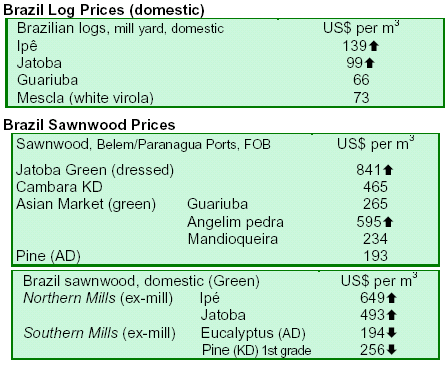
8. PERU
Peru¡¯s 2007 exports slide from previous year
The value of Peru¡¯s wood products sector exports from
January to December 2007 fell 2.25% from 2006 levels.
However, the average increase in the value of exports over
the period 1995 - 2007 was 16.13%. The value of Peru¡¯s
exports in December 2007 was USD5.95 million, higher
than that during same period of 2006.
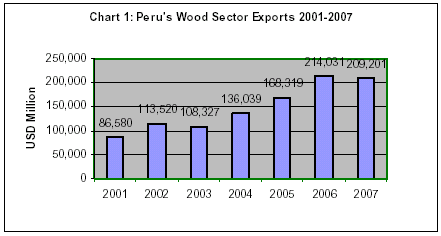
The fall in the value of exports during December 2007 was
caused by 1) the reduction of mahogany exports, which
previously boosted the value of Peru¡¯s exports due to its
high value; 2) Chinese importers shifting their preferences
to kiln dried instead of wet sawnwood; and 3) the
weakening US construction sector during the second half
of 2007, which softened demand for structural timber from
Spanish cedar and walnut. Items with the highest levels of
growth in 2007 were plywood (11.21%) and furniture and
components (9.16%). Exports decreased for sawnwood (-
5.83%) and structural timber (-8.64%). Exports of
fiberboard and chipboard (-56.38%) and sheets, parquet
and veneer (-92.85%) fell as these products were targeted
to the domestic market instead of the export market, where
demand has subsided for these products.
Sawnwood was still the main exported item, representing
51.69% of the sector. Sawnwood exports for 2007 were
USD108.1 million, falling from USD114.8 million in
2006. Although mahogany sawnwood exports decreased
during this time, other species such as tornillo, congona,
marupa and Spanish cedar rose slightly in 2007. Semimanufactured
products represented 26.36% of the market
share, increasing 5.72% in 2007 from 2006 levels. Growth
of semi-manufactured products exports was due to the rise
of decking and skirting boards exports to Canada, France,
Sweden and Mexico. The US was still the main
destination market for furniture and components, even
though its market share of Peru¡¯s wood products dropped
by 10% in 2007. Other destination markets such as Italy,
Venezuela, Chile and Ecuador increased their share of
Peru¡¯s wood products exports in 2007.

The main destination market for
Peru¡¯s wood products
was Mexico, as it received 33% of wood exports. The US
fell to second position from its top position in 2006 due to
its decrease of sawnwood imports and ongoing economic
problems in the country. China held the third position,
losing a slight market share due to falling prices for
species such as cumaru. Although the US, Mexico and
China are still the main destinations for Peru¡¯s wood
products exports, EU markets are gaining in importance,
especially Spain and Italy.
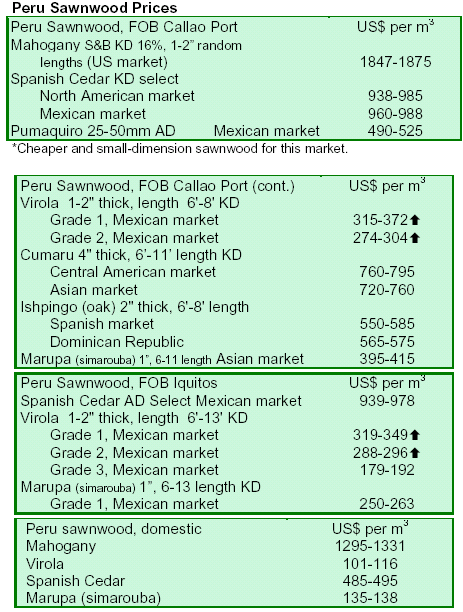
9. BOLIVIA
EXPOFOREST 2008 to be held in March
The sixth international forest sector fair (EXPOFOREST
2008), organized by Fexpocruz, the Forest Chamber of
Bolivia (CFB) and the Forest Superintendent¡¯s Office, will
be held from 26-29 March 2008 in the city of Santa Cruz
de la Sierra, Bolivia. The exhibition space, which is
already 90% full, will host companies from Argentina,
Bolivia, Brazil, China, Spain, France, Paraguay and Peru.
EXPOFOREST will cover an area of 6,500 m2 where
furniture, technology, garden and landscape products will
be on display. The area will also show new advances in
machinery, heavy equipment and portable sawmills.
Business roundtable to be held in conjunction with EXPOFOREST
From 27-28 March 2008, the CFB will convene the Fourth
Business Roundtable, where suppliers and consumers of
wood will discuss business developments in the sector.
The CFB expects that more than 200 participants from
over 20 countries will attend. The Roundtable hopes to
generate interest in business deals worth over USD20
million.
ITTO and Bolivia to convene national forest investment forum
The Bolivia Chamber of Forestry and ITTO will convene
the ¡®Bolivia Investment Forum¡¯ to discuss strategies and
information on the potential of tropical forest investment
in the country. The Forum, which will take place during
26-27 March, will be held in conjunction with
EXPOFOREST 2008. The investment forum will also
include an analysis of the major international markets for
tropical wood, industrial plantations, bioenergy, carbon
markets and investment opportunities within the region.

10.
Guyana
Sawnwood prices fall on sliding demand from the
South Pacific
Prices for logs, sawnwood and plywood remain relatively
stable. Prices for purpleheart logs rose 10 percent over the
previous fortnight and over 30 percent from the same
period last year. However, there were some declines in the
prices for sawnwood, most notably undressed purpleheart
sawnwood, which fell about 30 percent from the previous
fortnight. This decline was the result of lesser exports to
higher priced markets in the South Pacific.
GFC holds stakeholder consultations on revised wood processing standards and LUS
The Guyana Forestry Commission (GFC) hosted
consultations in several regions of Guyana to further
inform operators and stakeholders on revised standards for
wood processors and the utilization of a broader range of
species. The aim is to improve practices in the industry
and raise recovery rates to 70% by 2011, up from the
current 35-40% levels. The current revised standards take
into consideration recommendations made by producers
during 2007. The GFC had been carrying out consultations
with forest stakeholders to inform them about the
application and properties of a broader range of timber
species. This was aimed at making optimal sustainable
use of the resources available, especially in areas where
transportation costs are high and prime commercial
species may not be extensively available.
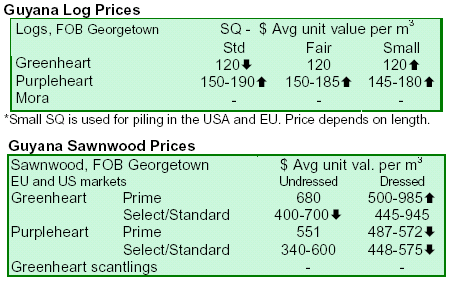
|